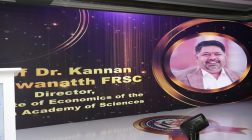Over 1 billion doses of vaccines worldwide & counting: Dr Krishna Ella gifts India of its 1st cell-cultured swine flu vaccine : India’s First & World’s biggest Research Driven Innovation

Mumbai: 27th November 2010 : Dr Krishna Ella defied all odds that came on his way & carried out his first love – Researching out Cross-disciplinary interaction between biotechnology and business in the fast-developing world in the form of Indian made single-dose vaccine named HNVAC to help the country fight the spread of the disease, when many thought that he is wasting his time & that in india it is better to copy than to innovate. Dr Ella, an alumnus of the University of Wisconsin and the founder Chairman of Bharat Biotech International Ltd in Hyderabad with his wife relentlessly pursued research against all odds as they had to spend the first months convincing banks to loan them money, or how to avoid becoming dependent on local labor unions or to figure out the biggest challenge to find out how to make a cheap hepatitis B vaccine. Ella had his higher education in USA,and when he came back to India to establish the firm..met lot of practical difficulties to obtain loan and understand about the Indian system…he came with little money to start his firm…and taken time to overcome the difficulties…It is really great some one..leaving USA and wants to serve for own…country. In the end, Ella prevailed and brought the cost of hepatitis B vaccines down from U.S. prices to one much more affordable for the developing world as C. Durga Rao, professor of virology at Bangalore’s Indian Institute of Science says He single-handedly brought down the price of Hepatitis B vaccination from $22 per child to a few pennies. Ten years ago Krishna Ella spotted that the purification method SmithKline Beecham used to extract the vaccine protein was relatively inefficient and costly. The multinational was using – and still uses to this day – a technique called ultracentrifugation, in which samples are subjected to 100,000 times gravity to separate the protein from DNA. The equipment cost over $1.5 million and only recovered 15 per cent of the protein. What is more, the technique used caesium chloride, which is expensive and has to be completely removed from the final product because it is toxic… The vaccine protein has a phospholipid tail that is electrically neutral, unlike most of the yeast proteins and DNA, which carry an electrical charge. With Ella’s method, called the Himax technique, the vaccine protein can be made to precipitate out of the solution onto a special matrix, while all the charged molecules stay put. Bharat has since started manufacturing other products, such as a typhoid vaccine and an antibiotic for use against staphylococcus bacteria.
In an exclusive interview to Satya Brahma, Chairman & Editor-In-Chief of Pharmaleaders, Dr Krishna Ella said “The most significant milestone in this millennium was the moment when we served over 1 billion doses of vaccines worldwide”…..On new drug Discovery & Research Dr Ella Said “For companies to be innovative and risk-taking, they need comfort at early stage of entrepreneurship and innovation as the incubation period is the most challenging and hard to maintain. The issue is that we continue to follow the Biogeneric and bio similar model of business. It is important for entrepreneurs to be innovative, research-oriented and create IPR. Unless we solve the IPR and build strong patent, statutory and execution regime, the FDI will always be difficult to come by. If these are made strong, the entrepreneurs can drive innovation. Then, the FDI will not be a big challenge. We should stop following the bio-generic and Bio-similar model and move towards innovation and research”.
In India, we still talk about bio-generic or bio-similar which is not good for the country because of which we lose our innovation and cost arbitration for the country. We never wanted to be a Bio- Generic or Bio- Similar Company. Our pursuit was always to move away from this and find solutions and build an eco-system to be innovative and encourage creation of IPR. Giving back to the society is equally important for an organisation. Of course to make the organisation successful it is very important to be innovative, besides People resource management, building corporate assets, be globally competitive, demonstrate highest standard of executive and top level management, bring in financial discipline, and chalk out long-term investments, added Dr Ella in his typical style.
The total global market for influenza including 2009 H1N1 according to estimates is likely to be 46,000 crore ($10.4 billion) during the current winter (2009-2010). The addition of adjuvant and shift to cell cultures can stretch the present global production capacity to increase protection for world population. The results of clinical trial with tested 2009 H1N1 vaccines indicate that a single dose may offer protection to over 90 percent of the vaccinated subjects.The global H1N1 influenza vaccine market is expected to show a high compound annual growth rate (CAGR) from 2009 to 2011; but as most of the global population is expected to be immunized by the end of 2011, a more moderate growth is expected in future. The H1N1 vaccines market is classified into intramuscular and intranasal vaccines sub-markets, of which the former holds the major share as he says our expectation is government involvement and increasing awareness on the pandemic to drive the growth of H1N1 vaccines market; thus encouraging market players to gain a better understanding of the market dynamics, technological innovations, product pricing, marketing and regulatory framework. He however says that HNVAC is the only flu vaccine to be manufactured in cell culture in the developing world — a highly sterile and controlled manufacturing process, instead of eggs. HNVAC was tested extensively in one of the largest phase I, II and III clinical trials for flu vaccines in India; and has proved safe and well tolerated. The key benefit of our cell culture vaccine is its potential to scale up and produce large quantities quickly as required; it also has a much more sterile and faster production cycle, without the external dependence on eggs, thus enabling quicker response times, in the event of a pandemic”.
You can see the full interview in the December Issue of Pharmaleaders Magazine or at www.pharmaleaders.co.in










